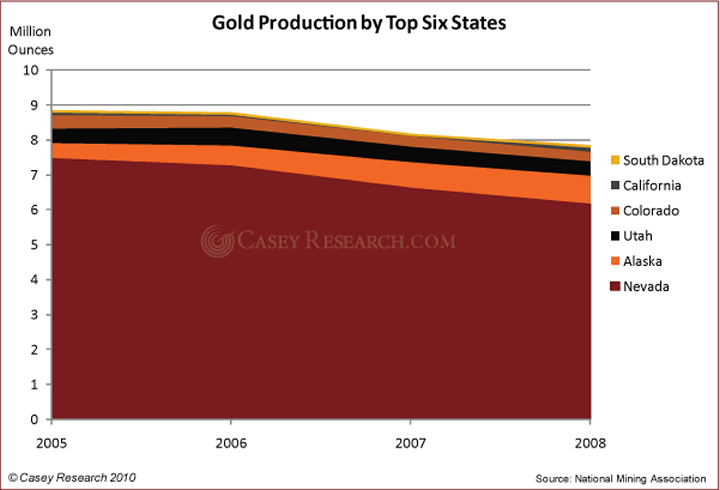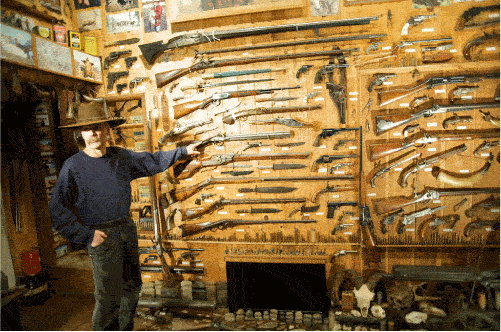Alaska’s New Gold Mining Rush
Commodities / Gold and Silver 2010 Sep 23, 2010 - 03:06 PM GMTBy: Casey_Research
 Louis James, Senior Editor, Casey’s International Speculator writes: Alaska is one of the most prospective and yet most underexplored areas in the world. There are good reasons for the neglect, most notably the long, cold winters and the lack of infrastructure. Whether the latter is a result of, or a cause of, there being few people in the state is an open question.
Louis James, Senior Editor, Casey’s International Speculator writes: Alaska is one of the most prospective and yet most underexplored areas in the world. There are good reasons for the neglect, most notably the long, cold winters and the lack of infrastructure. Whether the latter is a result of, or a cause of, there being few people in the state is an open question.
One clear result, however, is a rather small economy: Alaska’s 2009 GDP was US$47.3 billion, comparable to that of the Dominican Republic or Bulgaria. The state is ranked 44th by GDP among its U.S. peers.
In terms of metals, Alaska produces gold, silver, copper, lead, and zinc. Being well endowed with natural resources, Alaska’s mining history dates back to the early 1800s, when Russian explorers prospected the region, looking for placer gold. But not until after Russia sold Alaska to the United States did exploration activities start to develop rapidly, both on placer and hard rock deposits.
Alaska has undergone not one but a series of gold rushes, the most famous being the 1890s Klondike Gold Rush, which actually centered on gold found just over the border in the Yukon Territory. That event drew many immigrants and spawned numerous settlements on the way to the Klondike, one of the principal routes having been through Alaska. Almost 13 million ounces of gold were produced by placer miners in the area. Since the end of the 19th century, mining has become an integral part of the state’s economy.
The following chart shows Alaska increased its gold production to 800,000 oz in 2008 (most recent data available), up 10% from 2007. That’s also about a 10% share of total U.S. gold production. Alaska is the second largest gold-producing state behind Nevada. It is remarkable to see production in Alaska rise while total U.S. production has been in decline for more than a decade.

Yet, most Alaskan gold comes from only a handful of mines – and that tells you something about the size of the deposits being worked. The two largest mines, Fort Knox and Pogo, account for more than 80% of 2008 total gold production, or 640,000 ounces. The Kensington project, which started producing gold just a month ago, is set to become the third largest. Perhaps. But these mines are small potatoes compared to some of the current projects being advanced toward production. Given that a million ounces of contained gold is considered a large gold mine, Alaska’s major deposits are genuine monsters: Pebble has 107.3 million ounces of gold, Donlin Creek has 42.3 million, and Livengood has 19.7 million. If these go into production, Alaska will rank as one of the world’s top gold producers.
Alaskan Moose vs. African Elephant
I like Alaska. I like the fact that many, if not most, Alaskans own guns – it’s one of the last remnants of American “rugged individualism” (though sometimes it seems that more Alaskans take pride in the rugged part than in the individualism part).

Now this is an Alaskan cabin!
But in my professional capacity as Doug Casey’s rock-kicker, it’s not Alaskan culture that I like the most. It’s the almost unique combination of being a huge, highly prospective mineral district in a stable, pro-mining jurisdiction. Many people argue that all the big deposits in safer jurisdictions have been found – but you don’t have to go to Africa and put up with corrupt, kleptocratic regimes to hunt big game.
Alaska is unquestionably elephant country (well, moose country, and moose are almost as big as elephants and much more foul-tempered) with work done this cycle identifying genuine monster deposits. And there is plenty of room in that great empty place to find more.
The Pebble Controversy
What about Pebble – doesn’t that cast doubt on Alaska as a mining jurisdiction?
No.
The fight over Pebble does not stem from a groundswell of anti-mining sentiment among Alaskans, but from objections by specific interests to the potential mine’s proximity to salmon spawning grounds. Alaska’s economy has been dependent on resource extraction from the get-go, and remains so. Fish are an important resource, but mining has also long been a part of local culture and is no more horrifying to most Alaskans than guns are. In contrast to the views of the parasitical class that inhabits Washington DC, guns are simply necessary and useful things to most Alaskans. Similarly with mining.
Culture aside, the basic fact of life in Alaska is that the economy has always been driven by natural resources, and for Alaskans, this is not just an abstract theory. The State of Alaska cuts a check to each resident every year, paying them a dividend on the royalties the state has collected from the oil industry. Most of the money in the state Permanent Fund that pays these dividends came from the North Slope oil fields – and those are in decline. The Alaska Pipeline is operating at half capacity now, and if it drops below 30% or so, they’ll have to shut it down. That opens up some interesting conjectures about the future, but the point at the moment is that individual Alaskans get a substantial check in the mail every year ($1,305 in 2009) that reminds them of the importance of the resource industry.
I’m not worried about Alaska turning anti-mine; Pebble’s problems are specific to that project.
Real Obstacles
The main problems for resource industries in Alaska boil down to two things: it’s expensive, and much of the place is remote. Actually, the fact that everything costs more in Alaska also has a lot to do with how remote the whole place is from the rest of the U.S., adding substantial shipping costs for many goods. It’s also more expensive to deal with winter up there, due to various factors ranging from heavy snow removal costs to extra insulation costs, etc. For a mining project, a simple rule of thumb I’ve heard some old-timers use is that everything costs twice as much in Alaska.
Within Alaska, the remoteness itself is a major hurdle. The place is huge, twice as large as Texas, four times as large as California or Montana. The state capital of Juno has only about 30,000 inhabitants – and you need a boat or a plane to get there. Anchorage, the only larger city, has only about a quarter of a million (Fairbanks, the next largest city, has about the same size population as Juno). There are very few roads connecting this scarce and scattered population, with small aircraft being a common and critical part of the transportation and supply web that connects them.
NovaGold’s (T.NG) Donlin Creek project, huge as it is, faces serious logistical challenges, with neither roads nor power for literally hundreds of miles in any direction. Normally, you’d ship diesel fuel into a remote location and run generators. I haven’t done the math myself, but the amount of fuel needed is so great, I’ve heard that it’s physically impossible to barge it in. Maybe they could build an airstrip for some of those C-5 Galaxy cargo whales. What they are currently working on is a feasibility study to see if they can build a gas pipeline that would stretch over 300 miles from Anchorage – but for that to work, Anchorage needs to find a new gas supply itself.
This may be why we seldom hear of small deposits in Alaska; it’s not that there aren’t any but that a deposit is not worth bothering with unless it is rich enough to pay for whatever infrastructure needs building.
Real Opportunities
On the other hand, this very issue of remoteness is also an advantage – at least for speculators in this metals cycle. Because the place is so huge and so much of it so far from … well, from everything, there are vast stretches of land that have seen little exploration. The fact that everything costs more in Alaska has also kept a lot of exploration dollars away, in spite of how prospective the ground is – basically the same geology we love in BC and the Yukon. For well-funded and well-run companies, this is a true “land of opportunity.”
One of Louis’ favorite Alaskan companies has done a terrific job drilling off a monster gold deposit relatively close to the producing Fort Knox gold mine – and with a road onto the project. Louis thinks it has excellent chances of becoming a mine, particularly since the state of Alaska wants the project to go forward so it can collect its royalty. Sign up for a risk-free trial with 3-month money-back guarantee today. More here.
© 2010 Copyright Casey Research - All Rights Reserved
Disclaimer: The above is a matter of opinion provided for general information purposes only and is not intended as investment advice. Information and analysis above are derived from sources and utilising methods believed to be reliable, but we cannot accept responsibility for any losses you may incur as a result of this analysis. Individuals should consult with their personal financial advisors.
© 2005-2022 http://www.MarketOracle.co.uk - The Market Oracle is a FREE Daily Financial Markets Analysis & Forecasting online publication.



